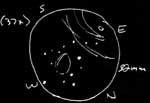
Observation Notes:
M110 appears very dim and diffuse. It is larger than M32, but much harder to see. It is elongated NW to SE and sort of points to M32. It is about 3/4 of a degree from the core of M31 to the west. It has a soft, low luminosity profile that doesn’t show a pointlike core like M31 and M32.
Factoids:
M110 is the second brighter satellite of the Andromeda Galaxy. It is about the same distance as M31 (about 2.9 million light years), and contains some unusual dark structure which is probably dust clouds. M110 also contains 8 notable globular clusters in a halo surrounding it. Charles Messier discovered it in 1773, but never included it in his original catalog. It was added as the last addition to his catalog in 1966 by Kenneth Glyn Jones.
| Subject | M110/NGC 205 |
| Classification | Elliptical Galaxy |
| Position | Cygnus [RA: 00:40.4 / Dec: +41:41]* |
| Size* | 17′ x 10′ |
| Brightness* | 8.5 |
| Date/Time | 10/4/04 – 10:35 PM |
| Observing Loc. | Flagstaff, AZ – Home |
| Instrument | Orion SVP 6LT Reflector (150 mm dia./1200 mm F/L) |
| Eyepieces/Mag. | 32 mm (37X) |
| Seeing | 4/10 |
| Transparency | Mag 5 |
* Based on published data.